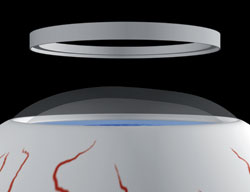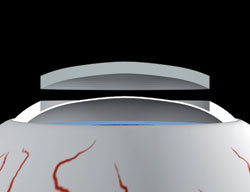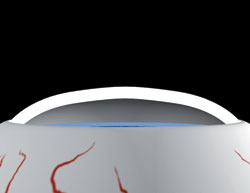Laser keratoplasty procedure offers precise corneal ablation
SAN FRANCISCO — Pachymetry-guided keratoplasty offers individualized treatment, low complication rates and strong visual outcomes, two surgeons said here.
Maria Clara Arbelaez, MD, and Cesar Carriazo, MD, discussed pachymetry-assisted laser keratoplasty (PALK) during a symposium sponsored by Schwind at the American Society of Cataract and Refractive Surgery meeting.
“We’ve become excited to see how a lamellar procedure … can be so easy and precise, and we have the technology available,” Dr. Arbelaez said during the symposium.
PALK is a safe procedure with a short learning curve, she said in a subsequent e-mail interview with Ocular Surgery News. To date, she has performed five PALK procedures.
“Pachymetry-assisted laser keratoplasty is an easy, safe and highly precise procedure to replace damaged corneas,” Dr. Arbelaez said. “It is suited for patients who need corneal transplants and whose endothelium is intact.”
The procedure’s main benefits include individualized and precise ablation of corneal tissue, uniform residual stromal bed thickness and shorter treatment time. The noncontact procedure significantly reduces trauma to the eye and involves precise centration with eye tracking, she said.
Optimal stromal bed thickness
A pachymetry map is generated with the Galilei Dual Scheimpflug Analyzer (Ziemer) with eye tracking, Dr. Arbelaez said. An ablation profile is created, allowing residual stromal bed thickness of 100 µm.
The Amaris laser (Schwind) is used to ablate the recipient stromal bed, which normally takes about 3 minutes. Precise ablation provides a uniform residual stromal thickness to deliver an optimal match for the donor button.
 A masking ring is gently positioned on the cornea, providing sharp edges for the ablation. |
 The calculated ablation volume is removed with the Schwind Amaris laser, ensuring short ablation time and high precision. |
 The corneal graft is implanted and secured with sutures. |
 The perfect matching of the graft and the stromal bed ensures superior visual results. Images: Schwind |
Graft fixation is enhanced by uniform stromal thickness due to isostatic properties, so the stromal bed has no transversal rigidity.
“This means that only forces along its main axis can stress it,” she said. “A membrane will always place itself along isostatic lines. For this reason, once the ablation is concluded, the bed will place itself along the isostatic line, which eliminates deformation induced by the cone. Patients gained extra corneal thickness and almost normal corneal anatomy, with regular donor-host interface, inducing a minor amount of astigmatism.”
Indications and contraindications
Indications for PALK include keratoconus without central opacity, post-LASIK ectasia, corneal opacity or corneal scarring without endothelial damage, and anterior corneal dystrophy (basement membrane dystrophy or Reis-Buckler’s dystrophy). The procedure is also indicated for patients with complications from radial or astigmatic keratotomy, Salzmann’s degeneration, and traumatic, bacterial or viral scarring.
PALK is contraindicated for pregnant or nursing women and patients with collagen vascular, autoimmune or immunodeficiency disease, severe local infection or allergy (blepharitis, previous herpes simplex or herpes zoster), full-thickness corneal opacity and uncontrolled glaucoma. It is also contraindicated for patients for whom measurement with a Scheimpflug camera or ultrasonic pachymetry cannot be performed, Dr. Arbelaez said. – by Matt Hasson

- Maria Clara Arbelaez, MD, can be reached at Muscat Eye Center, P.O. Box 938, PC 117, Muscat, Oman; 968-2469-1414, ext. 510; fax: 968-2460-1212; e-mail: drmaria@omantel.net.om. Dr. Arbelaez receives travel fees from Schwind.
